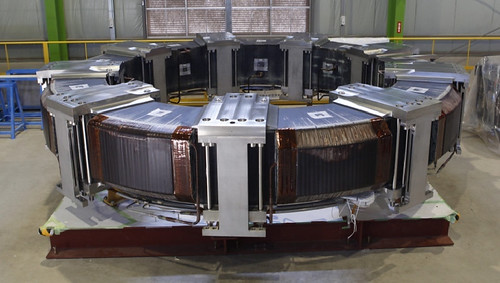供應日本本州七個縣的「東北電力公司」,由於面臨當地民眾的強烈反彈,28日宣布停止在福島核災區附近興建新核能電廠的計畫,也就是浪江-小高核電廠,這座電廠原本於1968年決議興建於福島第一電廠的北方10公里處。
東北電力公司的兩座核電廠,一座在宮城縣,一座在青森縣。在2011年3月11日地震和海嘯造成福島第一核電廠冷卻水裝置停擺、造成氫爆和核燃料融化,引爆福島核災後,這兩座核電廠和日本其他50多座核電廠目前皆處於停擺的狀態,僅剩兩座位於大阪附近的核電廠尚在運轉。
目前世界上所有的核電廠皆以分裂原子的核分裂技術來發電。但是現在日本積極發展核融合發電技術。核融合是太陽和恆星產生能量的方式。在此種核反應中,原子核以高速互相撞擊,產生新型態的原子核,並發出極高的熱和能量。
科學家們正努力鑽研核融合技術,作為新一代的發電方式。3月底,日本和歐洲科學家開始在東京東北方的茨城縣那珂市組裝一座最新核融合測試設備。地點位於日本太平洋海岸,福島第一核電廠南方143公里處。
25日上午,約100位來自日本和歐洲的人士參加了日本原子力開發機構那珂核融合研究所舉行的測試設備組裝開工儀式。
新的 JT-60SA測試設備將會取代最近進行的JT-60升級實驗,並使用建築物的基礎設施。 JT-60SA的超導體基座則是從歐洲直送到日本。
SA取超級(Super)和進階(Advanced)的第一個英文字母,因為JT-60SA將使用超導線圈,並用以研究電漿作業的進階模式。
預計有約500位日本和歐洲學者參與JT-60SA的核融合實驗。那珂JT-60SA的實驗將支援國際熱核實驗反應爐計畫( International Thermonuclear Experimental Reactor, ITER)。ITER計畫是一個國際性的核融合反應研究和工程計畫,目前正在法國Cadarache興建世界最大的實驗性環磁機反應爐。
ITER總幹事辦公室傳播和公關主任Michel Claessens博士表示,新測試設備在ITER結束後也將繼續支援後續興建的核融合電廠。ITER的目標是證明核融合可用於發電,並取得設計和運作核融合電廠所需的資料數據。
JT-60SA是以環磁機為基礎的實驗裝置,運用磁力將高熱的氣體鎖在環形的圓柱狀容器裡。氣體每小時會被加熱至超過1億度100秒。
JT-60SA以氫或重氫為電漿燃料。在真實的反應爐或是ITER中,重氫會模擬反應中的氘氚電漿的行為,但不會產生大量熱能或中子。反應產生部分中子和副產物氚。反應過程中JT-60SA漸漸變得具放射性,因此電漿旁必須設置遙控控制裝置。
JT-60SA核融合測試設備預計於2018年完工。
The Japanese utility that supplies electricity to seven prefectures on Japan's main island of Honshu today officially withdrew its plan to build a new nuclear power plant near the site of the 2011 Fukushima nuclear disaster.
Tohoku Electric Power Company said Thursday that it will cancel the construction of the Namie-Odaka plant in view of strong local opposition.
Announced in 1968, the plant was to be built about 10 kilometers (six miles) north of the damaged Fukushima Daiichi plant belonging to Tokyo Electric Power Company.
At Fukushima Daiichi, hydrogen explosions and nuclear fuel meltdowns followed the March 11, 2011 earthquake and tsunami that shut down power to the water pumps that cooled the nuclear fuel rods.
Tohoku already has two nuclear power stations – one in Miyagi Prefecture and the other in Aomori Prefecture. But they remain shut down after the Fukushima disaster as do all Japan's other 50+ nuclear power plants, except for two near Osaka.
All the world's nuclear power plants generate electricity by splitting atoms in a process known as nuclear fission.
But now, Japan is taking a leading role in developing production of electricity by means of nuclear fusion, the process that powers stars and the Sun. In this nuclear reaction, atomic nuclei collide at very high speed and join to form a new type of atomic nucleus, emitting vast amounts of heat and energy.
Scientists have been working to harness nuclear fusion as a next-generation energy source.
This week, Japanese and European scientists began assembling an advanced nuclear fusion testing facility northeast of Tokyo in Naka, Ibaraki Prefecture. The site is on Japan's Pacific coast 143 kilometers (89 miles) south of Fukushima Daiichi.
About 100 people from Europe and Japan attended a ceremony Monday at Japan Atomic Energy Agency's Naka Fusion Institute to mark the start of assembling the testing facility.
The new fusion testing facility replaces the JT-60 Upgrade experiment recently operating there, using the buildings and basic site infrastructure. The super-conductivity base for the JT-60SA testing facility was shipped from Europe.
SA stands for Super, Advanced, since the experiment will have superconducting coils and study advanced modes of plasma operation.
Some 500 Japanese and European researchers are expected to take part in nuclear fusion experiments there.
The experiments at Naka will support and optimize the International Thermonuclear Experimental Reactor, ITER, an international nuclear fusion research and engineering project, currently building the world's largest experimental tokamak nuclear fusion reactor at the Cadarache facility in France.
Michel Claessens, PhD, head of communication and external relations for ITER's Office of the Director-General, told ENS that the new testing facility will also support the fusion power plants that are built after ITER.
ITER's aim is to show that nuclear fusion could be used to generate electrical power, and to gain the necessary data to design and operate the first electricity-producing plant.
JT-60SA is an experimental device based on the tokamak concept, in which a hot gas is confined in a torus-shaped vessel using a magnetic field. The gas will be heated to over 100 million degrees, typically for 100 seconds every hour.
The plasma fuel will be hydrogen or deuterium. Deuterium mimics the behavior of a reacting deuterium-tritium plasma in a real power reactor or ITER, without generating large amounts of heat or neutrons.
The reaction produces some neutrons directly, plus reactions with tritium, a by-product of one branch of the reaction. JT-60SA thus slowly can become radioactive in use, and remote handling of systems near the plasma must be planned.
Japan's JT-60SA nuclear fusion testing facility is scheduled for completion in 2018.
※ 全文及圖片詳見:ENS








